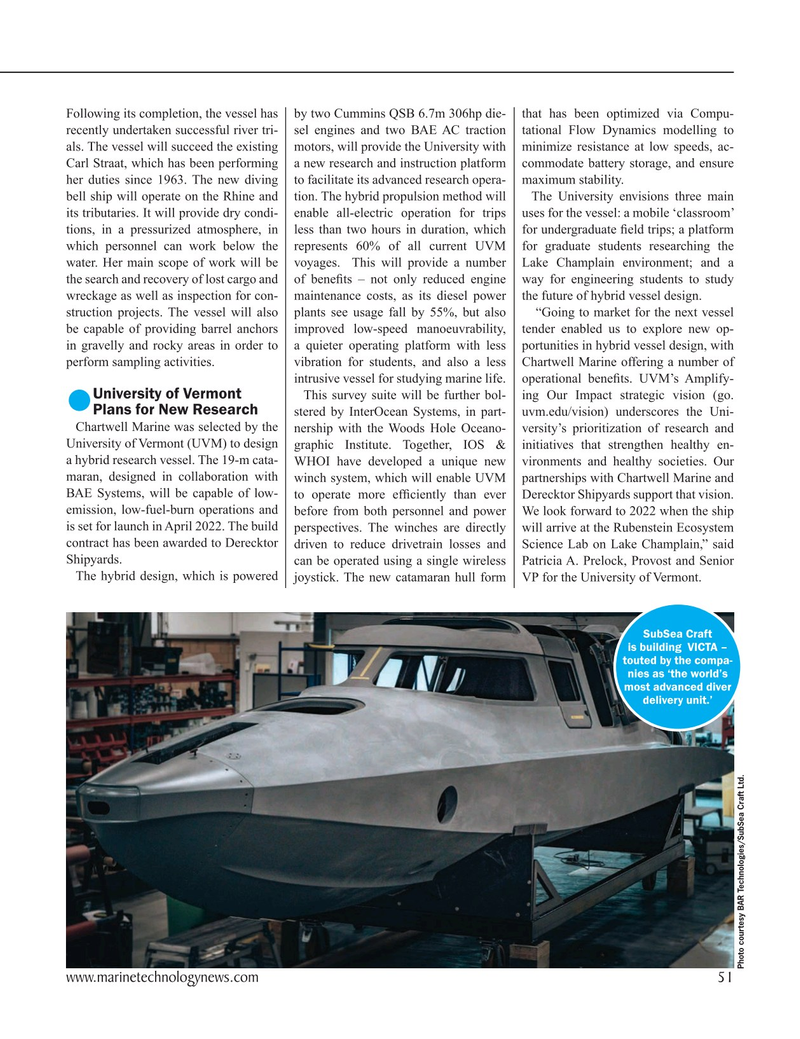
Page 51: of Marine Technology Magazine (January 2021)
Underwater Vehicle Annual
Read this page in Pdf, Flash or Html5 edition of January 2021 Marine Technology Magazine
Following its completion, the vessel has by two Cummins QSB 6.7m 306hp die- that has been optimized via Compu- recently undertaken successful river tri- sel engines and two BAE AC traction tational Flow Dynamics modelling to als. The vessel will succeed the existing motors, will provide the University with minimize resistance at low speeds, ac-
Carl Straat, which has been performing a new research and instruction platform commodate battery storage, and ensure her duties since 1963. The new diving to facilitate its advanced research opera- maximum stability.
bell ship will operate on the Rhine and tion. The hybrid propulsion method will The University envisions three main its tributaries. It will provide dry condi- enable all-electric operation for trips uses for the vessel: a mobile ‘classroom’ tions, in a pressurized atmosphere, in less than two hours in duration, which for undergraduate ? eld trips; a platform which personnel can work below the represents 60% of all current UVM for graduate students researching the water. Her main scope of work will be voyages. This will provide a number Lake Champlain environment; and a the search and recovery of lost cargo and of bene? ts – not only reduced engine way for engineering students to study wreckage as well as inspection for con- maintenance costs, as its diesel power the future of hybrid vessel design.
struction projects. The vessel will also plants see usage fall by 55%, but also “Going to market for the next vessel be capable of providing barrel anchors improved low-speed manoeuvrability, tender enabled us to explore new op- in gravelly and rocky areas in order to a quieter operating platform with less portunities in hybrid vessel design, with perform sampling activities. vibration for students, and also a less Chartwell Marine offering a number of intrusive vessel for studying marine life. operational bene? ts. UVM’s Amplify-
University of Vermont
This survey suite will be further bol- ing Our Impact strategic vision (go.
Plans for New Research stered by InterOcean Systems, in part- uvm.edu/vision) underscores the Uni-
Chartwell Marine was selected by the nership with the Woods Hole Oceano- versity’s prioritization of research and
University of Vermont (UVM) to design graphic Institute. Together, IOS & initiatives that strengthen healthy en- a hybrid research vessel. The 19-m cata-
WHOI have developed a unique new vironments and healthy societies. Our maran, designed in collaboration with winch system, which will enable UVM partnerships with Chartwell Marine and
BAE Systems, will be capable of low- to operate more ef? ciently than ever Derecktor Shipyards support that vision. emission, low-fuel-burn operations and before from both personnel and power We look forward to 2022 when the ship is set for launch in April 2022. The build perspectives. The winches are directly will arrive at the Rubenstein Ecosystem contract has been awarded to Derecktor driven to reduce drivetrain losses and Science Lab on Lake Champlain,” said
Shipyards. can be operated using a single wireless Patricia A. Prelock, Provost and Senior
The hybrid design, which is powered joystick. The new catamaran hull form VP for the University of Vermont.
SubSea Craft is building VICTA – touted by the compa- nies as ‘the world’s most advanced diver delivery unit.’
Photo courtesy BAR Technologies/SubSea Craft Ltd.
www.marinetechnologynews.com 51
MTR #1 (50-63).indd 51 1/25/2021 12:52:54 PM

 50
50

 52
52
